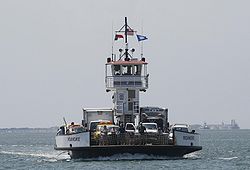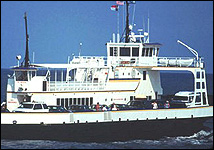|
North Carolina Department of Transportation Ferry DivisionThe North Carolina Department of Transportation Ferry Division is a branch of NCDOT that is responsible for the operation of over two dozen ferry services that transport passengers and vehicles to several islands along the Outer Banks of North Carolina. Three other inland, cable ferries—the Elwell Ferry, Parker's Ferry, and Sans Souci Ferry—continue in operation, under the direct oversight of the North Carolina Department of Transportation, and are not under the supervision of the Ferry Division. An additional coastal ferry servicing Hammocks Beach State Park is operated by the North Carolina Division of Parks and Recreation, and several private companies operate ferry services to sites such as Cape Lookout and Portsmouth Island. HistoryFerries have always played a vital role to the residents and visitors of Eastern North Carolina. The first ferries began in the mid-1920s when Captain J.B. "Toby" Tillett established a tug and barge service across Oregon Inlet along North Carolina's Outer Banks. In 1934, the North Carolina Highway Commission recognized the importance of this service to residents and began subsidizing Tillett's business. These subsidies kept tolls at an affordable level. In 1942, the Highway Commission began full reimbursement to eliminate the tolls. Tillett was fully subsidized until 1950 when his business was sold to the state. In 1947, the Commission purchased the ferry operations of T.A. Baum, who operated a route that ran across Croatan Sound and linked Manns Harbor and Roanoke Island. This became the first route of the NC Ferry System.  TodayThe North Carolina Department of Transportation Ferry Division extends over seven routes and one emergency route, has 22 ferries, and employs over 400 workers. The operations are supported by a full service shipyard at Manns Harbor and 10 support vessels, including dredge, military-style landing craft utility vehicles (LCUs), tugs, and barges. The Ferry Division operates over 200 sailings, with the ferries covering 1,200 miles (1,900 km) each day. The system includes the world's longest fare-free ferry route. Each year, North Carolina ferries transport nearly 1 million vehicles and more than 2 million passengers across five separate bodies of water - the Currituck and Pamlico sounds and the Cape Fear, Neuse, and Pamlico rivers. Ferries also carry essential goods to water-locked communities. Many residents depend on the ferries for transportation to school, work, and other needed services. Types of ferry boatsHatteras Class The North Carolina Ferry System operates seven Hatteras Class ferries. These Vessels draft only 4 feet, and are designed for the shallow waters and shifting shoals of Eastern North Carolina. Originally designed to carry 150 passengers, these ferries have been downrated to carry only 149 passengers with the introduction of new regulations regarding ferries capable of carrying 150 or more passengers. The Thomas A Baum was sold to a ferry company in the virgin islands. The Roanoke was sold to a ferry company in connecticut
River Class The Ferry System operates ten River Class ferries. These boats are designed for heavy, abusive use, and are double-ended (except the Hunt), meaning they do not have to turn around at the docks. This feature saves time on busy river routes. River class ferries are slowly replacing the older Hatteras class ferries.
Sound Class The North Carolina Ferry System operates five Sound Class ferries. These ferries are the largest in the system, able to carry up to 50 cars. These Ferries are designed to withstand the abuse of constantly traversing the shallow, turbulent waters of the Pamlico Sound. The M/V Pamlico has been sold to Cross Sound Ferry of New London, CT. The M/V Pamlico is the sister ship of the M/V Silver Lake.
Routes
Emergency route
TollsAs of April 2023, most of the ferries are free to use. The exceptions are the Cedar Island-Ocracoke, Swan-Quarter-Ocracoke, and Southport-Fort Fisher vehicle ferries. For the two Ocracoke ferries, the fares are $1 for pedestrians, $3 for bicycles, $10 for motorcycles, scooters, ATVs, golf carts, or three-wheeled vehicles, $15 for four wheeled vehicles up to 20 feet, as well as motorcycles with sidecars or trailers, $30 for vehicles 20-40 feet, and $45 for vehicles 40-65 feet. For the Southport-Fort Fisher ferry, the rates are $1 for pedestrians, $2 for bicycles, $3 for motorcycles, scooters, ATVs, golf carts, or three-wheeled vehicles, $7 for four wheeled vehicles up to 20 feet, as well as motorcycles with sidecars or trailer, $14 for vehicles 20-40 feet, and $28 for vehicles 40-65 feet.[4] References
External linksWikimedia Commons has media related to North Carolina Department of Transportation Ferry Division. |
|||||||||||||||||||||||||||||||||||||||||||||||||||||||||||||||||||||||||||||||||||||||||||||||||||||||||||||||||||||||||||||||||||||||||||||||||||||||||||||||||||||||||||||||||||||||||||||||||||||||||||||||||||||||||||||||||||||||||||||||||||||||||||||||||||||||||||||||||||||||||||||||
